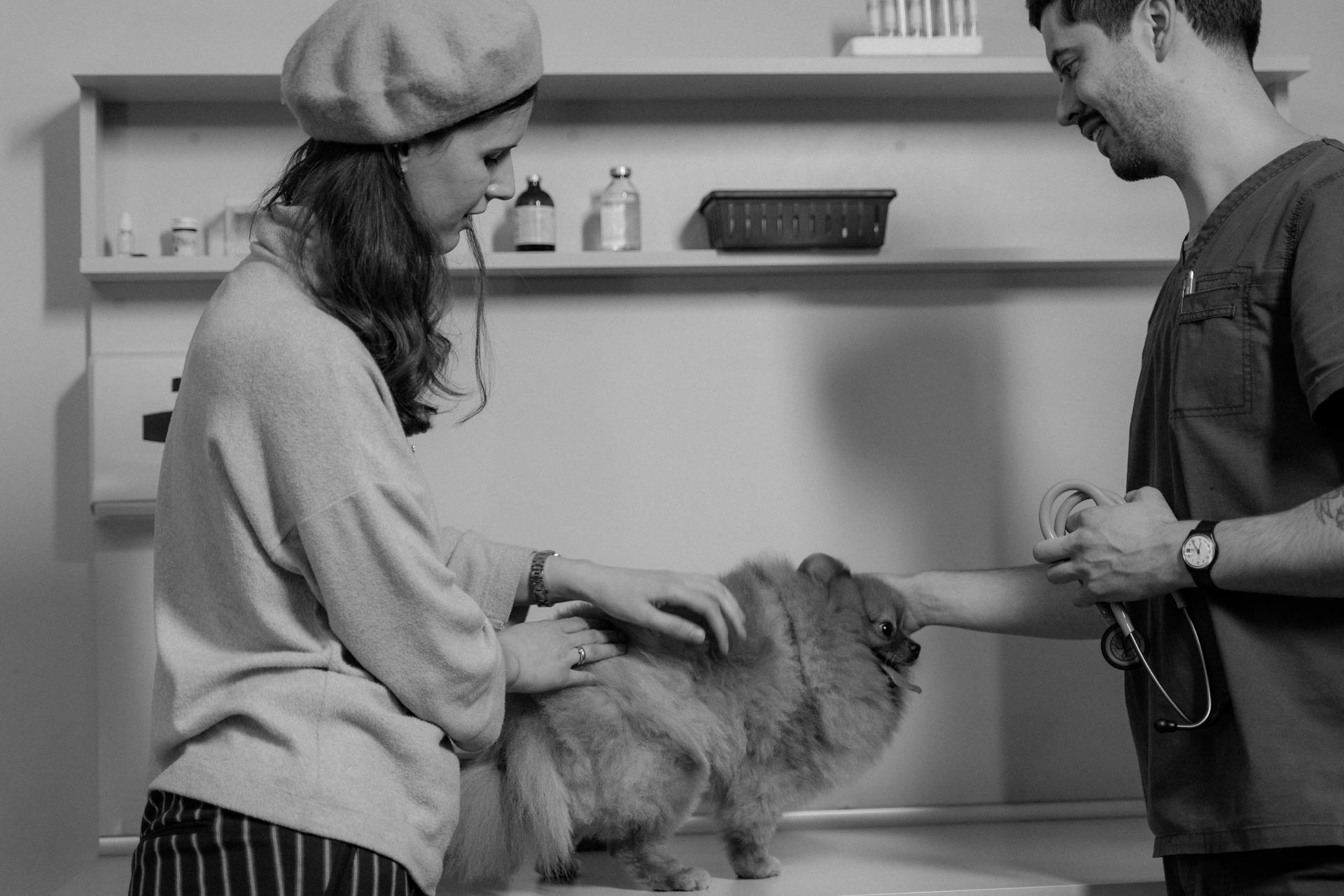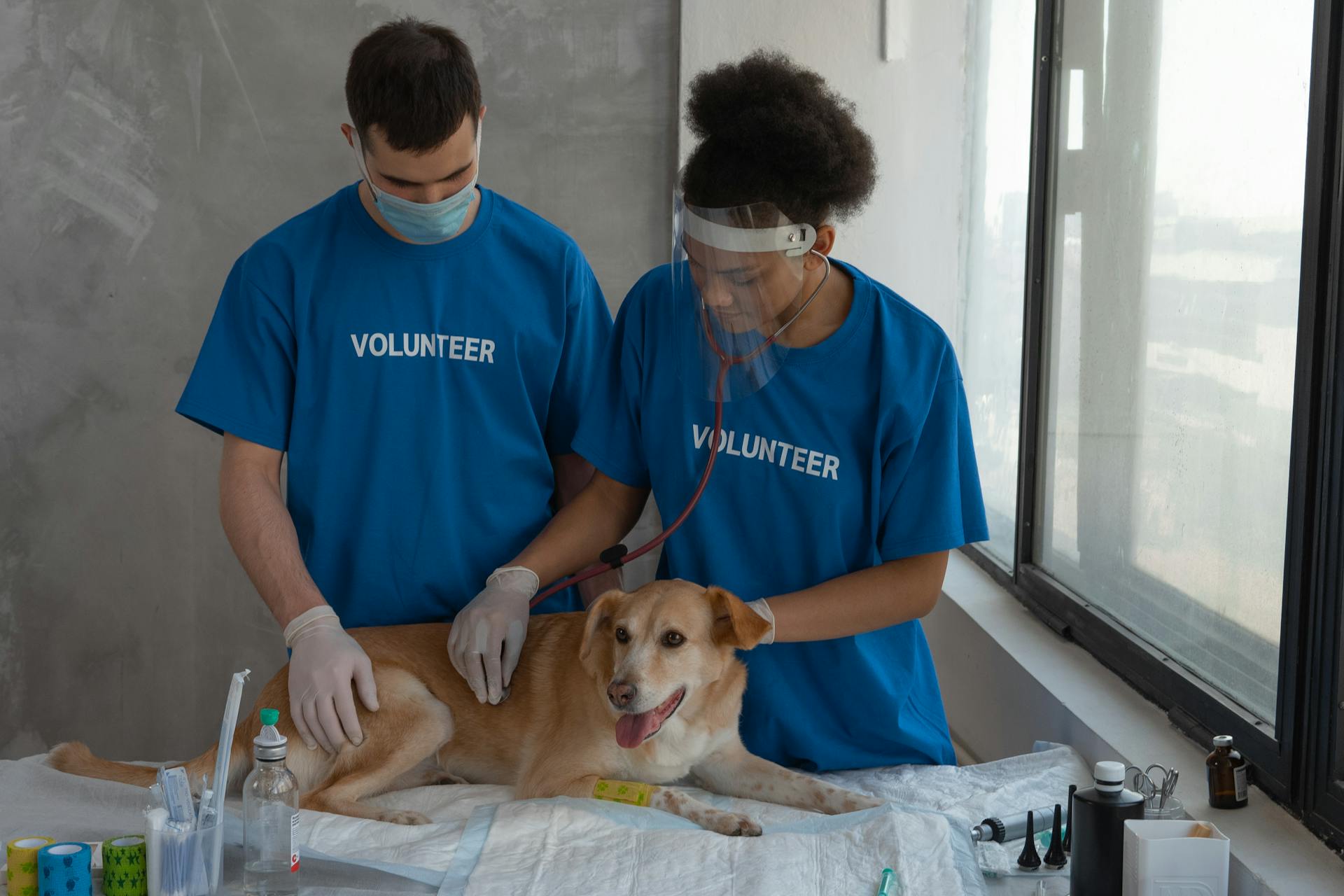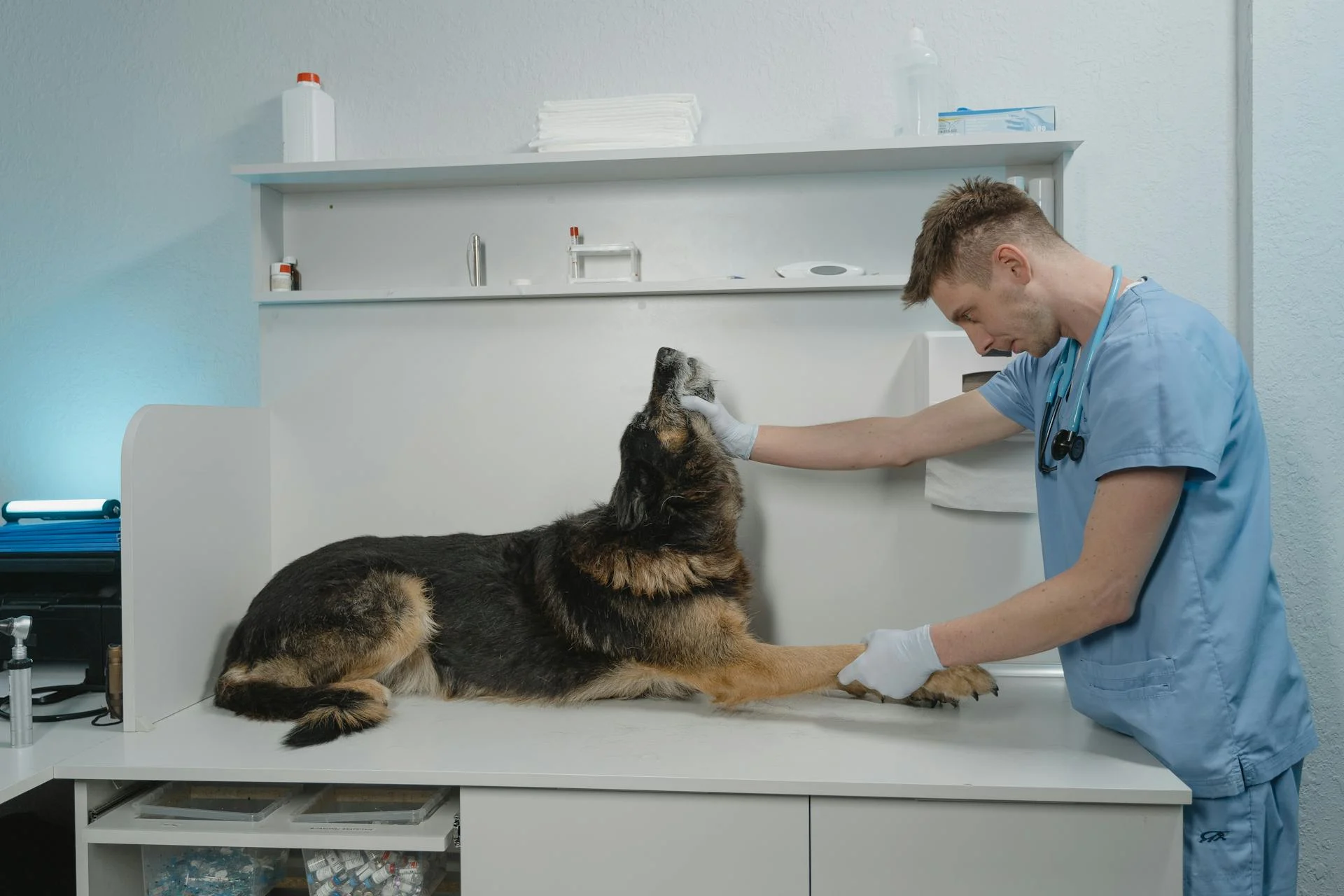
If you've noticed green discharge in your female dog, it's natural to feel concerned. Green discharge in female dogs can be a sign of a urinary tract infection (UTI), which is a common issue in dogs.
Green discharge can also be caused by a condition called pyometra, a life-threatening infection of the uterus that requires immediate veterinary attention. It's essential to know the warning signs.
If you notice green discharge accompanied by other symptoms such as vomiting, diarrhea, or lethargy, seek veterinary care right away.
If this caught your attention, see: Green Dog Training
What Causes?
Pyometra, a type of uterine infection, is a primary cause of green vaginal discharge in female dogs. This infection is often caused by the E. coli bacterium, which can occur a few weeks after the female dog completes her heat period.
Hormonal changes during each heat cycle can also lead to pyometra, as they cause the uterus to thicken with tissues to support pregnancy. These changes can weaken the uterus' ability to fight off infectious bacteria.
Curious to learn more? Check out: Female Dog Yeast Infection Treatment
Progesterone-based drugs can also contribute to pyometra, as they alter the uterus and make it more vulnerable to infection. If your dog is already taking hormone therapy for reproductive issues, it's essential to monitor her for pyometra.
The infection can cause green purulent discharge, which is a sign of the immune system fighting the microbes causing the infection. In some cases, this discharge can be a product of an infection in the urinary tract or reproductive system.
Here's a breakdown of the possible causes of green vaginal discharge in female dogs:
- Pyometra (a type of uterine infection)
- Hormonal changes during each heat cycle
- Progesterone-based drugs
- Other infections in the urinary tract or reproductive system
It's crucial to consider the context of the green discharge, as some pathologies only occur in specific situations, such as in puppies, pregnant dogs, or after labor.
Diagnosis and Treatment
If your dog is showing signs of green discharge, it's essential to get her to the vet as soon as possible. Early diagnosis is key to successful treatment.
The vet will ask about your dog's heat cycle and behavior, as well as any changes in her appetite or water intake. They may also perform a radiograph or ultrasound exam to check for swelling in the abdomen.
A unique perspective: Dog Names Female Start with S
A diagnosis of pyometra is often made based on a slight vaginal discharge, increased white blood cell count, and globulins in the blood. Some dogs may also have a painful, enlarged abdomen.
Surgery is the preferred treatment for pyometra, typically involving an ovariohysterectomy (spay) to remove the infected uterus and ovaries. This surgery is more complicated than a routine spay, but it's often the best option for a successful outcome.
Intravenous fluids and antibiotics may be needed before and after surgery to help manage the infection and prevent complications.
Take a look at this: Blood in Urine Dog Female
How Is Diagnosed?
Diagnosis usually starts with questions about the dog's heat cycle and any changes in behavior or self-grooming habits.
The vet may check for swelling in the abdomen using radiographs or an ultrasound exam.
A slight vaginal discharge with no prominent symptoms is often present in the initial stage of pyometra.
As the condition progresses, pets may show visible signs of illness.

Dogs with pyometra have an increased white blood cell count and globulins in the blood.
Painful, enlarged abdomen is also a common symptom.
Dogs that are seen early in the disease may have a slight vaginal discharge and show no other signs of illness.
However, most dogs with pyometra are not seen until later in the illness.
A very ill female dog that is drinking an increased amount of water and has not been sterilised is always suspected of having pyometra.
This is especially true if there is a vaginal discharge or painful, enlarged abdomen.
The specific gravity of the urine is very low due to the toxic effects of the bacteria on the kidneys.
Dogs with pyometra often have a marked elevation of the white blood cell count and an elevation of globulins in the blood.
Radiographs of the abdomen can identify the enlarged uterus if the cervix is closed.
However, if the cervix is open, the radiograph may not be conclusive.
An ultrasound examination can help identify an enlarged uterus and differentiate it from a normal pregnancy.
On a similar theme: Female Dog Vaginal
Treatment

Surgery is the preferred treatment for pyometra in dogs. The vet surgeon typically performs an ovariohysterectomy (spay) to remove the infected uterus and ovaries.
Dogs diagnosed in the early stages of pyometra are considered good candidates for a successful surgery. Early diagnosis is key to lowering the risks of complications.
Intravenous fluids (IV) are often needed after surgery to help your dog recover. Antibiotics may also be prescribed for a period of time after surgery to prevent infection.
Pyometra is a medical emergency that requires immediate treatment. If you notice symptoms or changes in your dog's behavior, it's essential to call your vet right away.
Worth a look: Female Dog Incontinence Treatment
Eye Clearing Time
Your dog's green eye discharge should clear within a few days or a couple of weeks at most, depending on the severity of the condition. This is assuming you've followed the recommended treatment protocol.
If you switch your dog to a species-appropriate raw or cooked diet, improve their gut health with canine probiotics, and do a semi-annual liver cleanse, you'll likely see an improvement in their eye health.

A semi-annual liver cleanse can help eliminate toxins and heavy metals accumulated in your dog's body, which can contribute to eye problems.
In some cases, it may take longer than expected for your dog's eyes to clear. If you don't see any improvement within a reasonable amount of time, take your dog to be examined by your veterinarian.
Here's a rough estimate of when you can expect to see improvement:
When and How It Happens
Pyometra, a serious condition that can affect female dogs, often occurs in unneutered females over age 6.
The risk of developing pyometra is higher when an unneutered dog is out of heat, a time when hormonal changes can lead to infection or pyometra in the uterus.
In many cases, pyometra happens about two to eight weeks after a dog's heat cycle, as the uterine wall undergoes changes that promote the disease.
Related reading: Pyometra in Pregnant Dogs
When Does It Happen?
Pyometra can strike at any time, but it's most common in older dogs. The disease often occurs in dogs that have been through many oestrus cycles.

The typical age range for pyometra is young to middle-aged dogs, but it's most common in older dogs. Many years of oestrus cycles lead to changes in the uterine wall that promote the disease.
Pyometra usually happens about two to eight weeks after a dog's oestrus cycle, also known as the "heat cycle". This is a crucial timeframe to be aware of if you're a dog owner.
How It Happens
Pyometra in dogs can happen to unneutered females over age 6, especially during the time they're out of heat.
As the heat period ends, hormonal changes can lead to an infection or pyometra in the uterus. This can happen to any unneutered dog, regardless of breed or size.
The chances of developing pyometra are higher in unneutered dogs during the post-heat period. It's essential to keep a close eye on your dog's health during this time.
In some cases, the uterus gets filled with pus, which can cause serious complications if not treated promptly. These complications can include blood poisoning, peritonitis, kidney failure, and even death.
Pyometra can be either open or closed, with open pyometra being more noticeable as you can see pus or blood coming out of the dog's vulva. Closed pyometra is more severe and can be life-threatening if left untreated.
Here's an interesting read: When Does a Female Dog Get Her First Period
Frequently Asked Questions
Is it normal for female dogs to have mucus discharge?
Vaginal discharge in female dogs is relatively rare, but can be a sign of a serious health issue. If you notice any unusual discharge, it's best to consult with a veterinarian to rule out any underlying problems
Sources
- https://www.animalwised.com/my-female-dog-has-green-discharge-3889.html
- https://www.webmd.com/pets/dogs/what-is-pyometra-in-dogs
- https://www.vetwest.com.au/pet-library/pyometra-in-dogs/
- https://townecenteranimalhospital.com/pyometra-causes-diagnosis-treatment/
- https://peterdobias.com/blogs/blog/steps-treat-dog-green-eye-discharge
Featured Images: pexels.com


